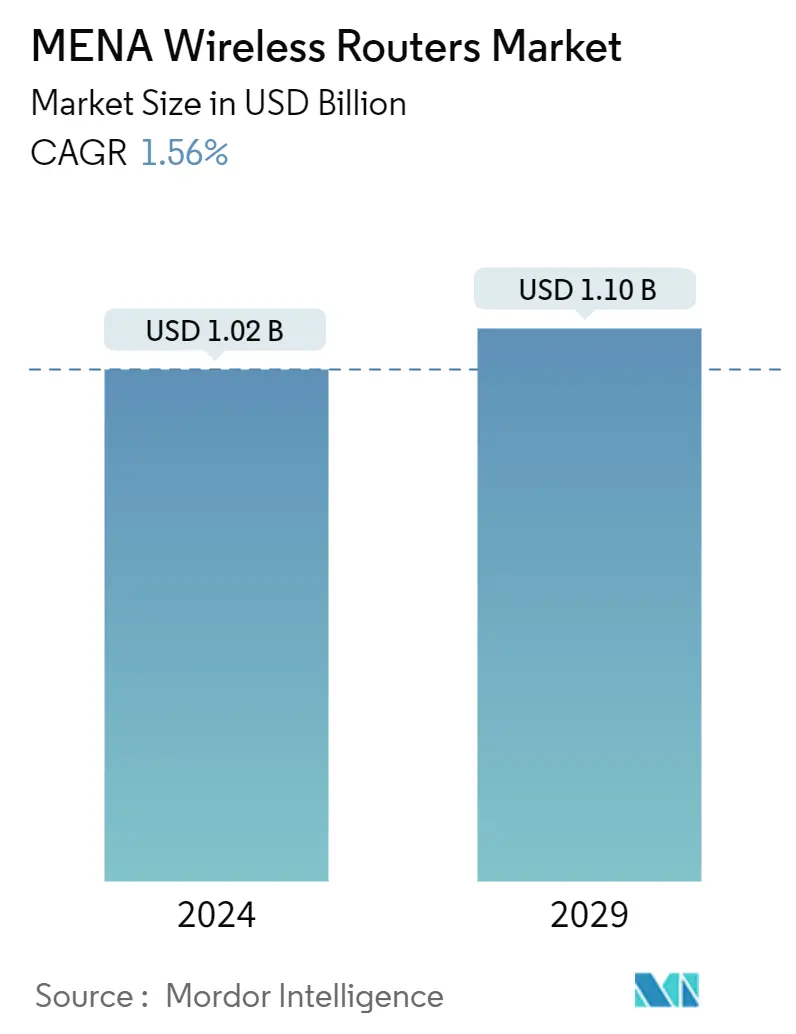Market Size of MENA Wireless Routers Industry

| Study Period | 2019 - 2029 |
| Base Year For Estimation | 2023 |
| Market Size (2024) | USD 1.02 Billion |
| Market Size (2029) | USD 1.10 Billion |
| CAGR (2024 - 2029) | 1.56 % |
| Market Concentration | Medium |
Major Players
*Disclaimer: Major Players sorted in no particular order |
Middle East and North Africa Wireless Routers Market Analysis
The MENA Wireless Routers Market size is estimated at USD 1.02 billion in 2024, and is expected to reach USD 1.10 billion by 2029, growing at a CAGR of 1.56% during the forecast period (2024-2029).
The increased application of data and internet services in the region would drive the growth prospects for Wireless Routers in the Middle East and North Africa region until the forecast period.
- Wireless routers include wireless access points that provide access to the internet or a private computer network. Depending on the manufacturer and model, it functions in a wired local area network, wireless-only LAN, or mixed wired and wireless networks.
- The major factor for the growth of wireless technology over the years has been the regularly changing standards set for improving the features of the routers.
- Wireless router technology has evolved steadily over the past decade, keeping pace with advances in standards set by the Institute of Electrical and Electronics Engineers (IEEE). These standards are updated regularly to improve network throughput in terms of maximum speeds and transmission capabilities.
- These upgrades have given the companies in the market the means to strive for innovation and have successfully satisfied the customers' demand for higher bandwidth and faster internet. The key market drivers are increasing consumer demand for web-enabled devices and growth in IP traffic.
- Moreover, the increasing demand for faster internet connectivity among consumers has deteriorated due to the high rise in the number of effective devices being connected, and this is spurring the demand for wireless routers with appropriate connectivity.
Middle East and North Africa Wireless Routers Industry Segmentation
A wireless router is a device that performs the functions of a router and includes the functions of a wireless access point with the help of a single, dual, and tri-band. Both residential and enterprise wireless routers are considered in the scope of the study.
The middle east and north africa wireless routers market are segmented by component type (product and services), by end user (residential and enterprise), and by country (Saudi Arabia, UAE, Qatar, Bahrain, Oman, Libya, Israel, Rest of MENA). The market sizes and forecasts are provided in terms of value (USD) for all the above segments.
| By Component Type | |
| Product | |
| Services |
| By End User | |
| Residential | |
| Enterprise |
| By Country | |
| Saudi Arabia | |
| UAE | |
| Qatar | |
| Bahrain | |
| Oman | |
| Libya | |
| Israel | |
| Rest of MENA |
MENA Wireless Routers Market Size Summary
The Middle East and North Africa wireless routers market is poised for steady growth over the forecast period, driven by the increasing demand for data and internet services in the region. Wireless routers, which include wireless access points for internet or private network access, are evolving with advancements in technology and standards set by the Institute of Electrical and Electronics Engineers. These advancements have enabled companies to innovate and meet the rising consumer demand for higher bandwidth and faster internet connectivity. The market is further propelled by the growing number of web-enabled devices and the surge in IP traffic, as well as the rapid expansion of internet users and Wi-Fi networks in the region.
The market landscape is competitive, with key players like Cisco, Nokia, D-Link, Huawei, and ASUS actively participating in strategic partnerships, mergers, and acquisitions to enhance their market presence. The COVID-19 pandemic has also spurred demand for wireless routers as remote work became the norm, leading to increased investment in IT infrastructure. The advent of IoT and Industry 4.0 is expected to further drive the replacement of cabled networks with wireless connections, particularly in industrial settings. Companies are introducing new products and expanding their offerings to cater to the growing market demand, with a focus on providing robust connectivity solutions that support smart home networks and high-speed internet services.
MENA Wireless Routers Market Size - Table of Contents
-
1. MARKET INSIGHTS
-
1.1 Market Overview
-
1.2 Industry Attractiveness - Porter's Five Forces Analysis
-
1.2.1 Bargaining Power of Buyers
-
1.2.2 Bargaining Power of Suppliers
-
1.2.3 Threat of New Entrants
-
1.2.4 Threat of Substitutes
-
1.2.5 Intensity of Competitive Rivalry
-
-
1.3 Industry Value Chain Analysis
-
1.4 Value proposition of broadband and Wi-Fi in the MENA countries
-
-
2. Market segmentation
-
2.1 By Component Type
-
2.1.1 Product
-
2.1.2 Services
-
-
2.2 By End User
-
2.2.1 Residential
-
2.2.2 Enterprise
-
-
2.3 By Country
-
2.3.1 Saudi Arabia
-
2.3.2 UAE
-
2.3.3 Qatar
-
2.3.4 Bahrain
-
2.3.5 Oman
-
2.3.6 Libya
-
2.3.7 Israel
-
2.3.8 Rest of MENA
-
-
MENA Wireless Routers Market Size FAQs
How big is the MENA Wireless Routers Market?
The MENA Wireless Routers Market size is expected to reach USD 1.02 billion in 2024 and grow at a CAGR of 1.56% to reach USD 1.10 billion by 2029.
What is the current MENA Wireless Routers Market size?
In 2024, the MENA Wireless Routers Market size is expected to reach USD 1.02 billion.

